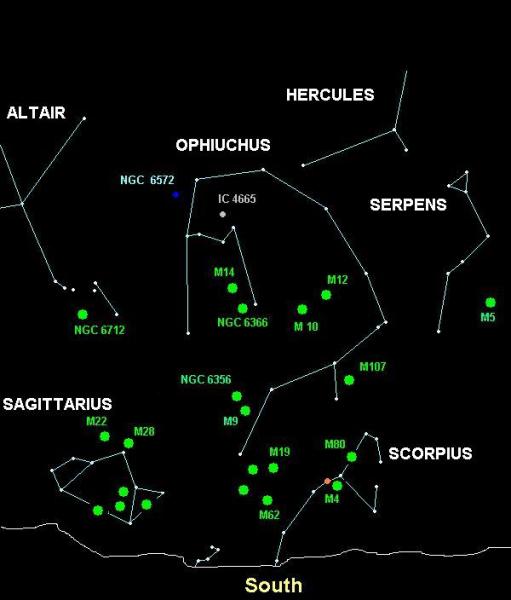Taming the Serpent
One of the largest constellations in the sky is Ophiuchus – the serpent holder. Located directly below Hercules, it lies on the meridian at about 9:30 p.m. at the beginning of the month. This huge area of sky covers close to a thousand square degrees and is home to no less than 13 globular clusters equal to or brighter than tenth magnitude. This means on nights of good seeing, you should be able to sweep up these treasures in simple binoculars.
We first begin with one of the brightest targets – M12. Glowing at magnitude 6.7, it has an estimated distance of 16,000 light-years (ly) and is about 75 light-years wide. M12 is one of Charles Messier’s original discoveries back in 1764. Using my 12 inch SCT telescope working at 195X from suburban Ottawa, the centre of this object was well resolved with a nice splash of about a few bright suns randomly sprinkled across it. M10 is a near twin of M12, also resolved and is a tad brighter along with being some 1,700 ly closer.
Moving east from our duo, we come across an even grey splotch with some resolved stars. This is M14 and is a full magnitude fainter than the past two objects and about twice as far. Higher power will show a little more detail but not much. Next, we will investigate a planetary nebula called NGC 6572. It is an irregular object glowing at magnitude 9.2. On exceptional nights or if you are capturing CCD images, you will recover the 11.5 magnitude central star. The late Walter Scott Houston once wrote that older people see this object as green but younger people see a bluish colour.

A very loose open cluster is IC 4665. With about 30 members to its name, this 4th magnitude grouping spans some 70 minutes (two full moons) width of sky and is best seen in binoculars. With so many treasures available to astrophotographers, the Rho Ophiuchus region has to rank as one of the top ten. It is the sum of a supergiant star named Antares (the heart of the scorpion), a marvellous globular cluster called M4 along with other blue reflective nebulae above it. Yes, the pastels of the heavens never cease to amaze me. Not too far up the Scorpion is M 80. It is over 32,000 ly from us and about 95 ly wide. M80 is a featureless magnitude 7.3 glow but is regarded as one of the richest clusters in the Galaxy.
Move your scope to the eastern side of Ophiuchus and you will come across what I like to call the M9 trio. M9 is a tiny mottled globular that looks like a fuzzy star. At about 26,000 ly, it is one of the closest to us. Look for the dark nebula known as Barnard 64. Located a moon’s width to the west, this dusty region almost spills into M9. The next two members of the trio are globulars NGC 6356 situated one and a half degrees to the NE and NGC 6342 down to the SE.
Another showpiece in the globular cluster category does to M5 in Serpens. This is a pleasure to view through any telescope. It beams at magnitude 5.8 and is a must-see for your list of objects. Catalogued as one of the oldest members of the Milky Way, M5 is huge – to the tune of 165 wide. Its age is an estimated 13 billion years old which brings back to the time just after the Big Bang.

Jupiter continues to dazzle the summer sky as it set around midnight on the first of the month. The latest feature on the Jovian cloud tops is the new storm – Red Spot Jr. It is scheduled to slide close to the famous Red Spot on July 4th. What will result from this close encounter is anyone’s guess. As our stellar gap is widening, the planet’s angular size is shrinking. At opposition on May 4th, it was 44.6 arcseconds wide, at the end of July it dwindles to 38.6 arc seconds.
Finally, the south delta Aquarid meteor will peak on the night of July 28th at 7 hours UT. It is not a great shower with only 20 meteors hourly per single observer. However, with a graceful speed of 41 km/sec, they will add to the beauty of warm July nights. A nine-day-old moon will not interfere.
Until next month – clear skies everyone.
Gary Boyle
garyboyle@sympatico.ca
